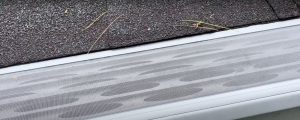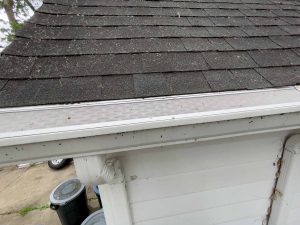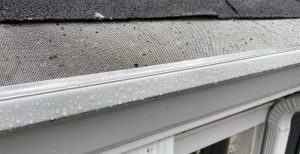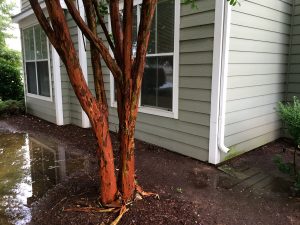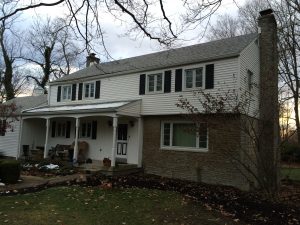If you’re reading this article, you might own a home with one or more roof valleys. You know, the area on your roof where two or more roof surfaces meet. A long or short channel that rockets water towards an inside corner of the house every time it rains. Made from metal, asphalt shingles, and rubber membranes, roof valleys are a challenge in good times and bad.
Let’s reveal the punch line up front: there’s not much you can do about optimizing water flows in roof valleys other than moving to a house that has nothing but straight runs of gutter.
In this article, we’ll reveal several options from a list of not-so-great options.
What is a Roof Valley?
A roof valley is literally a channel between two roof surfaces. If you were to draw a V, it would be the point of the V, but in a linear form. Roof valleys can be as short as a few feet and as long as 60-feet. For most homes, they’re likely no more than 30-feet long. The height and pitch of your roof determines how challenging a roof valley will be. The steeper the roof and the longer the valley, the more water will collect in it.
That water has to go somewhere, and it’s not uphill. If you have gutters installed on your home, the water in the valley will move downhill towards the gutters. Many homeowners have issues catching water in their open gutters. Oftentimes, you’ll see a tall piece of metal added to the outside edge of the gutter. This is called a diverter or splash guard.
What is a Splash Guard?
The intent of the splash guard is to deflect water from the valley back into the gutter. That’s right, if the diverter wasn’t installed, you might see water overshooting that inside corner and miss the gutter altogether.
Generally speaking, that may be true the harder it rains. On an everyday typical rain, water shouldn’t have much of a problem falling inside the gutter. The longer the valley and the steeper your roof, the more challenging this becomes.
Another common issue is that sometimes the gutters at the base of the valley are shorter than a long, straight run. This can present a problem because the volume of water that accumulates in the gutter can easily overwhelm it.
Installing Downspouts in an Inside Corner is a Bad Idea
We have also seen many instances where the gutter installer decides to locate a downspout at the inside corner of the gutter. When looking at the L of the gutter, he or she would install the downspouts at the angle between the two straight runs. Honestly, this is a terrible idea that exacerbates the water problem.
Wherever a downspout is located is generally the low point of the gutter run. A good place to put a downspout is near the end of a run, such as the outside corner of a wall. When you locate a downspout at the end of a straight run, it allows the water to progressively reach the downspout in an organized fashion.
If you install a downspout at the inside corner of a gutter, that means that water is converging from three areas: the valley above plus the two straight runs that make up the L. Essentially, all the water is pointing to the one place on the gutter where most of the water volume exists. Doubling and tripling the water flow into this spot is a recipe for disaster.
If you equate it to a river, imagine two or more rivers converging to form a single river. The mouth of the rivers will be the choppiest and most violent area, with water hitting the same spot from multiple directions. The volume will be 2 or three times what it would be if the downspout was located at the opposite end of a straight run.
Hopefully you get the idea: lots of water meeting in the same spot at the bottom of a valley means that you will likely experience water problems with or without gutter guards installed.
Gutter Covers Located at the Base of Roof Valleys
Now imagine that you install a gutter cover over the top of your existing gutters. What was once open is now covered. You’d agree that the best chance of maximizing water flow into your gutters would be to have the appropriate sized gutter, a downspout that is not located in the inside corner of your gutters, and no gutter cover installed.
Assuming this is your situation, then if we install a cover over your gutters, we’re restricting the water flow to some extent. The porosity of the gutter cover is going to determine to what degree water flow from the valley is restricted.
There are other variables such as water volume and velocity, but the point is, a cover over the top of the gutter is going to cut down on the amount of water that can enter into the gutter.
Take this one step further by installing a fine mesh gutter guard, such as MasterShield, or a hooded gutter cover, such as LeaFree, or even a perforated gutter guard panel such as Gutter Rx, and we’ve significantly cut down on the amount of water that can enter the gutters.
Remember, the best way to take in the most water is to have a gutter that is correctly sized, clean, pitched properly and with the downspout some distance from the inside corner of the gutter.
The problem is that this doesn’t address what’s inside the gutter. If you don’t have any trees or debris that lands on your roof and works its way into the gutter, then it’s a non-issue. You don’t need gutter guards.
But if you have trees with leaves and pine needles and sticks and maple seeds, then you’ve got to do something.
And by something, you’ll want to pick the best gutter guard for your environment. A gutter guard that will successfully repel and, ideally, shed leaves and debris off the top of the gutter covers.
That’s job #1.
A clean gutter means that you have the best chance of capturing water and moving it away from your home.
If that were that, we’d be done. This article would be finished.
But it’s not the only thing you have to worry about.
Job #1.1 is capturing water into your gutter covers
The more porous your gutter covers, the better job they’ll do collecting water. The more porous the gutter screen, the worse it will do deflecting and shedding leaves and debris.
The tighter the screen, the better it will do deflecting and shedding debris, but the worse it will do capturing water.
You get the idea.
It’s a series of trade-offs.
Roof Valleys are Magnets for Water, Leaves, Sticks and Debris
The problem with valleys is that not only do you get large volumes of water moving down the channel, but you also tend to collect the most leaves, sticks and debris from nearby trees. Add to it a big water diverter/splash guard at the leading edge of the gutter, and now you have a wall to keep the water in place but also a wall that will collect much of the debris that works its way down the valley, where it inconveniently sits on top of the gutter covers.
Not only is water an issue, because it can stream over the top of the gutter covers to the ground, debris is also an issue because it got stuck behind the splash guards that were installed on the gutters.
It’s one thing if the gutter is on a one level home, but it’s an entirely different issue if the gutters are 2 or more stories high.
Who wants to deal with that?
Here’s the answer: Nobody wants to deal with it. It’s not part of the gutter guards warranty. No gutter guard installer or manufacturer is going to warranty leaves and debris sitting on top of your gutter covers.
Just ask LeafFilter, who has been sued over claims that leaves and debris won’t collect on top of its gutter covers.
A splash guard at the leading edge — on the lip — of the gutter doesn’t do you much good after you’ve installed gutter guards because the water has gained so much momentum and the gutter cover has essentially restricted access into the gutters that the water is just going to skip around the splash guard and debris is going to get lodged in that corner.
What Can you do to Minimize Problems in Roof Valleys with Gutter Guards?
There are several options, none of which is great:
Remove Splash Guards
This is my personal preference. Sure, water will spill over the gutter covers when it rains, but you’ll likely never have to climb a ladder to remove all of the debris that will get stuck behind the splash guards in the valleys.
Even if you opt to install splash guards on the lip of the gutter, the ability of the splash guard to retain water dramatically decreases after installing gutter guards. This is true because the water is unable to enter the gutter now that it has a cover over it in the same way it used to enter the gutter when it was open.
Lots of people freak out when their mulch gets dislodged by the water that lands on the ground. We get it. It can be messy and disruptive and make a pretty area look unkempt. But there are ways around that. Add river rocks or stones in that area so that when the water lands on the ground, water simply splashes off the rocks and absorbs into the ground.
Install a Fish Pond
Fish ponds are a great way to relieve stress. When you’re outside stressing about the fact that water is cascading over the inside corner of your house, the fish pond will help calm you down.
Install a Rain Barrel
If the fish pond idea seems a bit over the top, a strategically placed rain barrel may do the trick. The advantage of a rain barrel is that it can collect a decent amount of water and then move the water well away from the home’s foundation with the addition of a hose. While the volume of water from the valley could quickly fill the barrel, keeping the hose on all the time, and putting the hose somewhere that moves the water away from the house or into another area that would benefit plants, trees, shrubs or the lawn, is an option.
Install Plants
Hosta and other hearty plants and shrubbery that like lots of water in the summer time may be a good way to break the water as it spills over the gutters and it keeps the plants well fed.
If you’re worried about water getting into your basement or crawl space or landing on doors or windows, then you’ve got to consider Plan B.
What is Plan B to Minimize Water Overflow in Roof Valleys?
Regrade Soil
If you’re worried about water getting into your basement, you can add dirt and grade it away from your foundation wall. Install plastic sheeting or weed barrier fabric over the dirt and then add stones or rocks on top of the plastic sheeting to help drive water away from the foundation walls.
Install a French Drain
We don’t know much about the mechanics of French drains, but you could install a water catchment system that would collect the water when it hits the drain and then carries it well away from your foundation walls.
Install Splash Guards
If you install a splash guard on the outside edge of the gutter after installing gutter guards, any benefit you enjoy will be short-lived. If it works to begin with, once leaves and debris build up behind the splash guard and on top of the gutter guards, the water will follow the path of least resistance and roll around the outside edge of the splash guards to the ground.
Since debris collecting on top of the gutter guards is not covered by a warranty, you’ll either need to hire someone to clean out this area or do it yourself.
Install a Roof Valley Water Diverter
Similar to a splash guard, a roof diverter is installed in the valley, on the roof, in an effort to intercept water before it makes its way to the gutters. Essentially, this is comparable to a splash guard, but installed on the roof in one or more places. It may be longer and taller or shorter than a splash guard, but helps disrupt the water flow by fanning it out on the roof.
The longer the valley, the taller the diverter needs to be.
A roof water diverter is likely the best of the options if you need a splash guard, but there’s still no guarantee that it will work as desired.
Hire a Landscaper, Gutter Cleaning Service or a Handyman with a Leaf Blower
If you have a lawn crew who cuts your grass, have them keep an eye on the inside corners at your house. They’re armed with tools of the trade, including leaf blowers, which they can easily aim towards the roof to dislodge and blow off leaves and debris in the inside corners.
If your roof is too high for your landscaper to access the gutters, then you can hire a gutter cleaner or handyman to blow off the roof and gutter covers as needed.
While this is an expense you were likely hoping to cut out of your budget, limiting the scope of the work to a few valleys and knowing that your gutter guards are working well on 99% of your home should provide peace of mind that the gutters will always remain free flowing and, whatever issues remain, are easily resolved with a quick visit up a ladder.
Gutter Guards Come with Tradeoffs. Decide what is Important to You!
Gutter guards were designed to keep leaves and debris out of your gutters. Unfortunately, its ability to capture 100% of the water off your roof isn’t possible in most cases. The best you can do is some research to find the best style of gutter guards that will work most effectively in your environment.
Be swayed less by sales pitches from companies that only offer one solution, and more by watching videos of gutter guards being tested in environments similar to or worse than yours.
Ask questions and realize that nothing is going to work perfectly 100% of the time. Simply find something that will work most of the time and accept the fact that there will be tradeoffs.
For most homeowners, while water spilling over the inside corner of a valley may not be desirable, it’s the #1 issue with gutter guards for homeowners who have valleys.
Exchanging some water overflow for free-flowing gutters and staying off the ladder seems like an acceptable tradeoff.
Do you agree?
Leave your comments below.
If you are looking for new gutter guards on your home, we may be able to help if you live within our service area. Call us at 1-800-750-2131 or request a free, in-home estimate online today.


